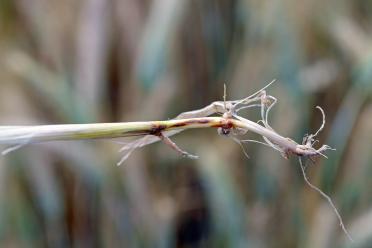
The discovery, from scientists at the Earlham Institute and Rothamsted Research, allows researchers to better study how similar species of Pezizomycotina fungus have evolved to adopt radically different lifestyles.
Several Pezizomycotina species are found in the roots of plants like wheat, where they can both prevent and cause devastating crop diseases such as take-all. Understanding how this happens could ultimately open the door to new strategies to boost crop yield.
In general, fungal genomes are much more dynamic than those of plants and animals, partly due to the action of mobile elements called transposons. These ‘jumping genes’ can move independently around their host’s genome, having both positive and negative effects as they proliferate.
Transposons’ DNA is often highly repetitive. This is challenging for conventional sequencing techniques to analyse, and this has held back efforts to study fungal genomes in detail. However, the development of long-read sequencing has allowed researchers to overcome these limitations.
Until recently, most known fungal transposons were relatively short stretches of DNA that only carried genes necessary to jump around the genome.
However, in 2022, US and Swedish researchers used long-read sequencing to reveal an entirely new class of giant transposon in Pezizomycotina. As large as 700kb, they appeared to carry a much greater range of genetic ‘cargo’.
The researchers called these ‘Starships’, and showed that they could transport large blocks of hundreds of genes between Pezizomycotina species, accelerating their evolution through a process called horizonal gene transfer.
Researchers have since identified more than 700 Starships, almost all of which carry a gene responsible for their ability to ‘jump’: a recombinase enzyme known as ‘captain’.
But because these elements are so diverse, containing such a wide variety of other genetic cargo and large amounts of repetitive DNA, they had proven very difficult to compare. This meant their origins and relationships to each other had proven hard to unravel.
In their new paper, published in G3, scientists used a technique known as k-mer based analysis to build a ‘tree of life’ that mapped out evolutionary relationships between different Starships for the first time using their entire sequences. Previous such analyses had tended to rely on comparing the sequence of just their ‘captain’ genes.
K-mer based analysis is a computational technique developed in the late 1980s. It allows researchers to rapidly estimate evolutionary relationships between genomes using probability statistics, rather than painstakingly aligning different sequences against each other.
The team’s findings suggest that ‘long range’ Starship jumps, ferrying cargo between distantly related Pezizomycotina species, are much less common than initially thought. Instead, they found signs that transfers were much more common between closely related species.
Lead author Dr Rowena Hill, postdoctoral researcher working with Dr Mark McMullan at the Earlham Institute, said: “The discovery of Starships in 2022 was a breakthrough in understanding how Pezizomycotina species have evolved. But to really understand how they impact the fungal genome, we needed to use a method that can compare whole Starships, even when their cargo is very different.
“Our findings show how k-mer-based analysis can refine how Starships can be studied, and home in on the rare events where these complex transposons seem to jump across large evolutionary distances.
"Understanding more about fungal evolution is really important. Fungi provide vital support to plants that are so essential to our society and ecosystem. On the other hand, they can also cause some of the most devastating crop diseases, like take-all. If we can understand how some fungi prevent disease, and others cause it – and how they can sometimes switch between these two modes - we could potentially engineer more sustainable agricultural techniques.
“This is even more important with the growing threat of climate change. Some fungi can change their behaviour in different environments, so understanding how a changing climate might affect fungal behaviour – and what role Starships play in this – is vital.”
The study was funded as part of the BBSRC cross-institute ‘Delivering Sustainable Wheat’ programme, with additional funding from DEFRA.